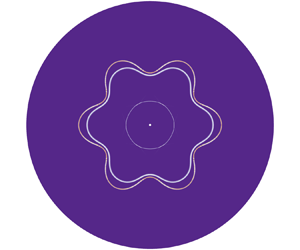Published online by Cambridge University Press: 25 November 2024

Developing a model to describe the shock-accelerated cylindrical fluid layer with arbitrary Atwood numbers is essential for uncovering the effect of Atwood numbers on the perturbation growth. The recent model (J. Fluid Mech., vol. 969, 2023, p. A6) reveals several contributions to the instability evolution of a shock-accelerated cylindrical fluid layer but its applicability is limited to cases with an absolute value of Atwood numbers close to  $1$, due to the employment of the thin-shell correction and interface coupling effect of the fluid layer in vacuum. By employing the linear stability analysis on a cylindrical fluid layer in which two interfaces separate three arbitrary-density fluids, the present work generalizes the thin-shell correction and interface coupling effect, and thus, extends the recent model to cases with arbitrary Atwood numbers. The accuracy of this extended model in describing the instability evolution of the shock-accelerated fluid layer before reshock is confirmed via direct numerical simulations. In the verification simulations, three fluid-layer configurations are considered, where the outer and intermediate fluids remain fixed and the density of the inner fluid is reduced. Moreover, the mechanisms underlying the effect of the Atwood number at the inner interface on the perturbation growth are mainly elucidated by employing the model to analyse each contribution. As the Atwood number decreases, the dominant contribution of the Richtmyer–Meshkov instability is enhanced due to the stronger waves reverberated inside the layer, leading to weakened perturbation growth at initial in-phase interfaces and enhanced perturbation growth at initial anti-phase interfaces.
$1$, due to the employment of the thin-shell correction and interface coupling effect of the fluid layer in vacuum. By employing the linear stability analysis on a cylindrical fluid layer in which two interfaces separate three arbitrary-density fluids, the present work generalizes the thin-shell correction and interface coupling effect, and thus, extends the recent model to cases with arbitrary Atwood numbers. The accuracy of this extended model in describing the instability evolution of the shock-accelerated fluid layer before reshock is confirmed via direct numerical simulations. In the verification simulations, three fluid-layer configurations are considered, where the outer and intermediate fluids remain fixed and the density of the inner fluid is reduced. Moreover, the mechanisms underlying the effect of the Atwood number at the inner interface on the perturbation growth are mainly elucidated by employing the model to analyse each contribution. As the Atwood number decreases, the dominant contribution of the Richtmyer–Meshkov instability is enhanced due to the stronger waves reverberated inside the layer, leading to weakened perturbation growth at initial in-phase interfaces and enhanced perturbation growth at initial anti-phase interfaces.